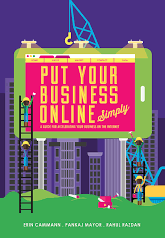5 Essential E-Commerce Website Design Tips Keep your small business website looking sharp

Whether you own a hair salon, a hotel, or a law practice, there's no doubt that you are an expert at running your business. On the other hand, a skill like website design is probably not in your immediate wheelhouse. That said, you still recognize that having a robust online presence is necessary for businesses in every industry.
Before launching a small business website, brush up on these five basics of e-commerce website design.
Quick-Loading Pages
Imagine stopping by your favorite clothing store to pick up a few of the new season's must-have items. You arrive, only to find the door is stuck. The salespeople in the store try to pry it open, but you're not able to enter for a few minutes. Now, imagine this happens every time you go to the store. You'd probably stop shopping there, right?
The same is true for websites with slow-loading pages. Most web users have access to quick-loading websites, and have little patience for anything else. Make sure your e-commerce site loads quickly, or you're at risk for losing valuable customers. Choose a site design that has optimized HTML and images, and doesn't use Flash or other slow-loading components.
Visible (and Error-Free) on Mobile Devices and Browsers
A growing majority of people are shopping on e-commerce sites from mobile devices, like iPhones and iPads. This shift means that your e-commerce site should be optimized for mobile, and accessible across a variety of devices. Additionally, it's important your site also be optimized across various browsers, including Chrome and Firefox, so that users can visit and shop without encountering errors.
Easy-to-Use Online Shopping Cart
An online shopping cart is actually software that can be integrated onto your site, and which displays your product showcase, and allows people to purchase and pay for items. Make sure you choose a shopping cart that has a clean, easy-to-use design so that your user experience (UX) isn't compromised when people shop for goods. If they cannot easily select and purchase items, chances are they won't find favor with your store and shop elsewhere.
Accept Multiple Payment Types
Make sure that in addition to offering a solid UX design, your site accepts multiple payment types, including credit cards and PayPal. This should also include the ability to incorporate online discounts.
Integrate CRM and Contact Management
When you choose a design for your website, it's also important to consider the backend of your site. Make sure to incorporate contact management features which allow you to gather important information from your customers, including names, email addresses, and phone numbers.
Additionally, it's even more important to have access to customer relationship management tools (CRM), which track and analyze customer behavior on your website. The information provided by CRM allows you to create targeted marketing campaigns for your most valuable customers.
Rather than spend your precious time and energy creating your own small business website using a DIY website builder, choose to create your online business using a website building platform, like Ocoos. A platform includes professionally designed e-commerce website templates that integrate all of the features discussed above.
Moreover, Ocoos offers a full-service concierge who will work with small business owners to create websites that meet their goals and user needs. The concierge builds the website in its entirety, and owners have access to make updates to the site if they choose to do so. US-based, 24-hour customer support is also available.


